This post may contain affiliate links. Please see our disclosure policy for more details.
Butternut squash is an amazing first food for babies. Here’s how to cook it as well as serving suggestions for 6 months and up.
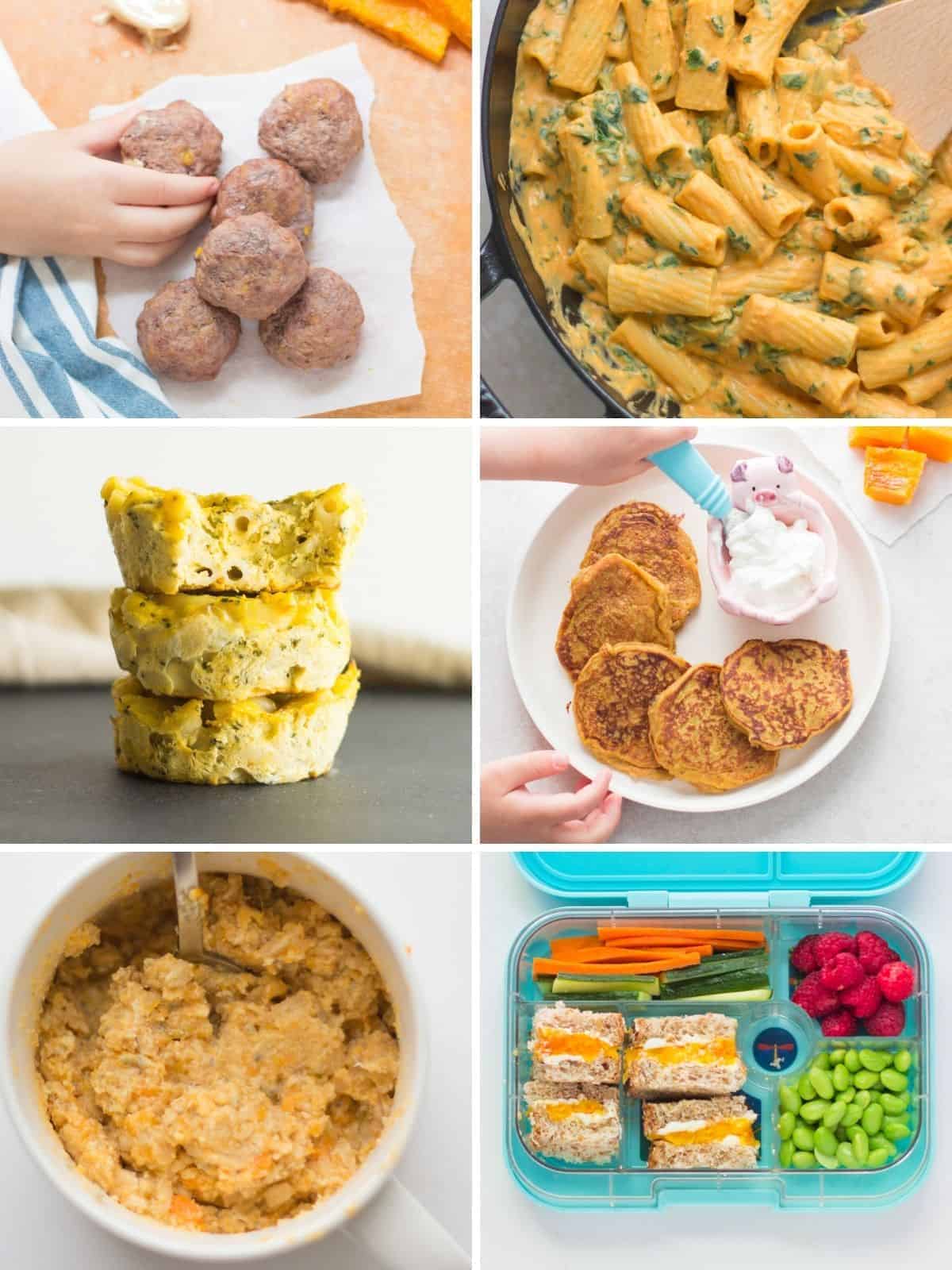
Table of Contents
When can babies eat butternut squash?
Butternut squash can be offered to babies as soon as they’re ready to start solids, usually around 6 months. It’s important to remember that your baby is unique and that rather than going by the calendar, you need to make sure your baby is DEVELOPMENTALLY ready to start solids.
If you’re unsure, be sure to grab my FREE handout!
Healthy benefits
Interesting fact! Butternut squash is technically a fruit because it contains seeds, just like spaghetti squash, pumpkin, avocados, tomatoes.
It’s not only delicious and versatile, but it is also loaded with vitamins, minerals, and antioxidants.
It’s particularly high in:
- Vitamin A – important for eye and bone health and immune function
- Vitamin C – helps boost immunity and enhances iron absorption
- Magnesium and potassium – aid in optimal bone health
Just like mangoes, its bright orange color is due to an antioxidant called carotenoids, which gets converted into vitamin A. Carotenoids are fat-soluble compounds, so they are best absorbed with fat.
Last but not least, it’s also a great source of both soluble and insoluble fiber.
Is butternut squash safe for babies?
As long as it’s offered in an appropriate size and texture, it is safe. Let me show you how! Butternut squash allergy is very rare as well.
Related: Best First Foods for Babies
Selecting the best squash
Look for one that’s solid, dull dark beige in color, and doesn’t contain any green streaks on the skin. Make sure there are no serious cuts or soft spots.
It should feel firm and heavy for its size. I like to pick up several that are similar in size and choose the heaviest one. Make sure the stem is intact.
Cooking Methods
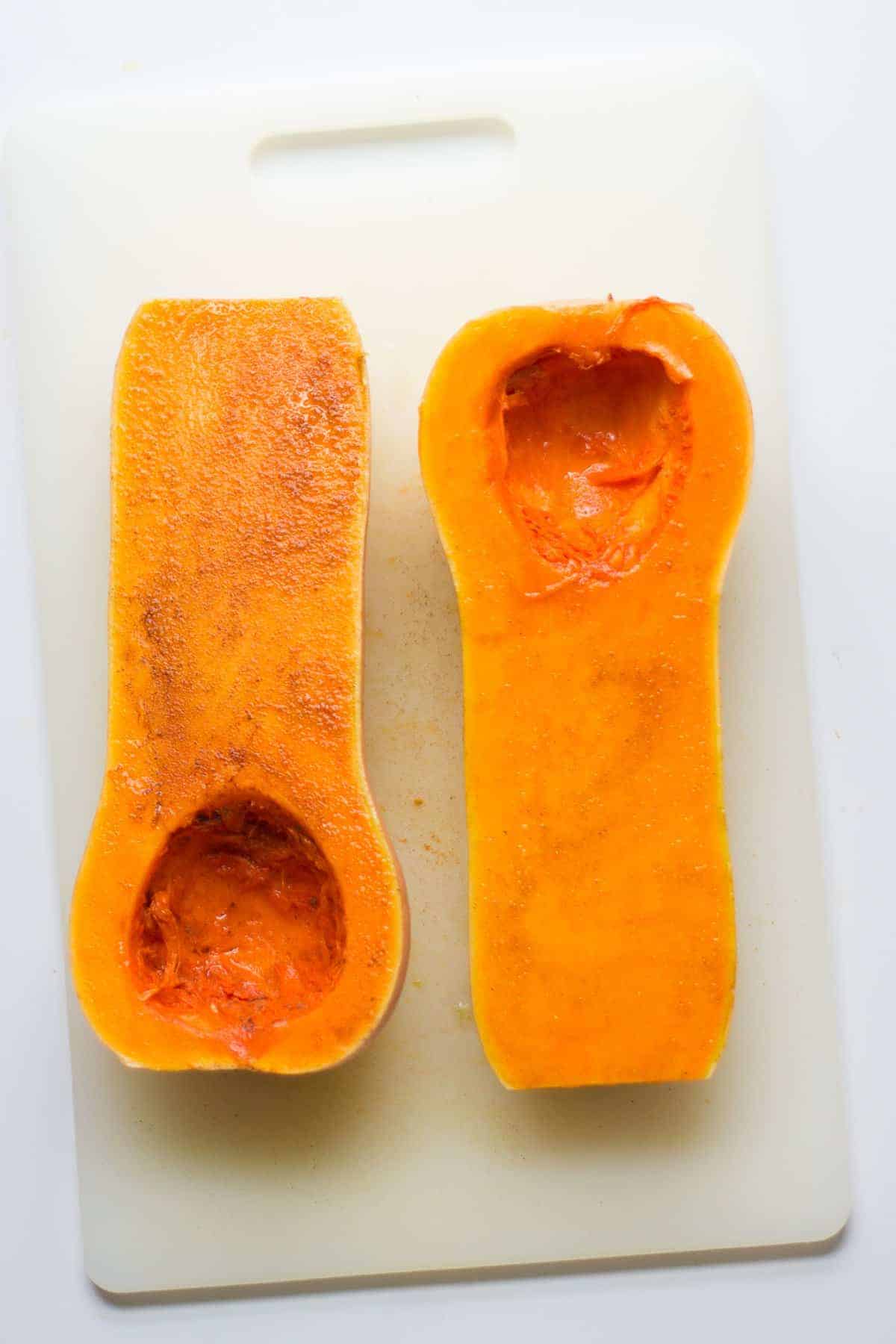
It’s VERY important that the squash is cooked until soft enough to be easily smooshed between thumb and forefinger.
Steamed
Place water in a pot, add steamer basket, and bring to a boil. Add the squash, cover, reduce heat to medium, and cook for 15 minutes.
Turn off the heat and let it sit covered for 5 minutes to continue steaming. It should be easily pierce-able with a fork.
Roasted
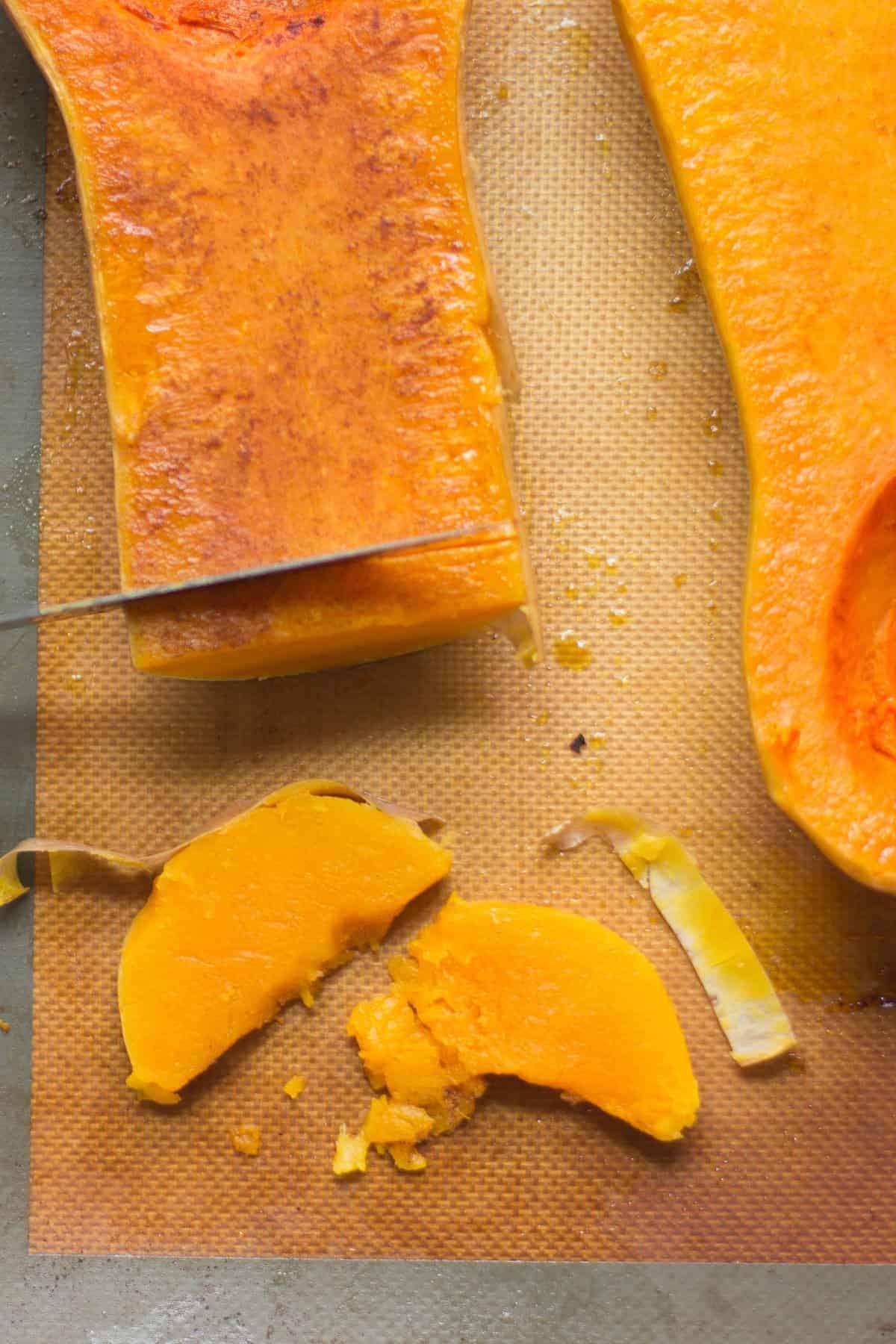
Roasting is the easiest and most flavorful way to cook the squash (or any vegetable for that matter). Soft and caramelized flesh – yes please! This is actually the only cooking method I use to cook our squash.
- Cut squash in half – Trim the stem end and cut the squash in half. Remove the seeds. Coat both the skin and flesh with oil. You can also add seasoning(s) at this time.
- Cook for 30-45 minutes, for 1 1/2 to 2 pound squash.
How to cut for baby led weaning
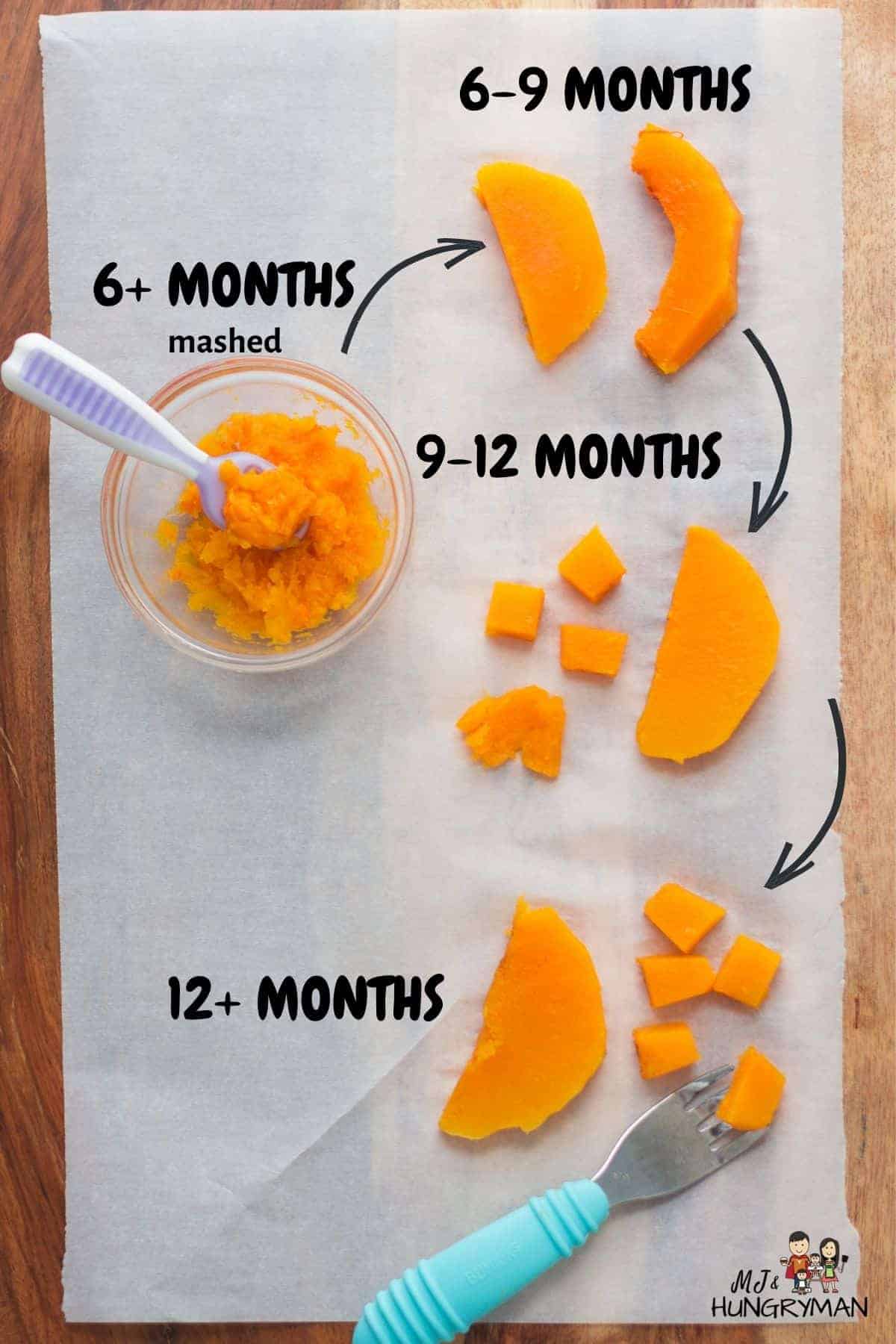
6+ months old
Pureed – Add cooked squash into a blender and blend until smooth. Add breastmilk/formula, water, or even broth to thin out to desired consistency.
Mashed – Whether you are advancing in texture after doing purees or starting with baby led weaning, this is such an easy and versatile way to serve the squash to your baby.
Simply mash with the back of a fork and add to:
6-9 MONTHS OLD
Bigger is better and safer at this age so your baby can easily grab the food with their palm and bring to mouth.
Cut into thick strips or half-moon shapes. Again, the squash should be easy to smush between your thumb and forefinger.
Related: Right food size and texture for baby led weaning
9+ MONTHS OLD
As your baby develops their pincer grasp and is able to pick up small pieces of food using their thumb and finger, you can cut into small, bite-sized pieces. I still suggest continuing to offer larger pieces so they can practice taking bites.
I emphasize this because my son was the ultimate shoveler, and cutting into small pieces only made it worse. With my second baby, I offered her large pieces along with bite-sized pieces, and it’s definitely helped her to slow down and to take bites rather than shovel.
If you haven’t already, this is a good time to introduce utensils. Your baby will most likely just play around or toss it. But it’s still great for exposure!
Try forking a piece of squash and plate on their plate. Be sure to continue modeling. They are like sponges and learn by watching you!
12+ months old
Continue practicing with those utensils! When serving mash, use the hand-over-hand method to guide your baby’s hand to scoop with a spoon. Same goes for forking a bite-sized piece.
Again practice practice practice, with a lot of patience sprinkled in. It’s a skill that takes time to master.
How to Store
For uncooked
Whole squash can be stored in a cool, dark place for up to 3 months. Once cut, wrap the squash in plastic wrap or store in an airtight container for up to a week in the fridge.
For cooked
Store in an airtight container for 3-5 days in the fridge.
To freeze
You can either flash freeze or puree and freeze in a tray (I LOVE this one) for up to 3 months.
Frequently Asked Questions
It is edible and a great source of fiber, vitamins, and minerals. However, it really depends on the age of the squash. With some, the skin gets tender once roasted, but some have a thicker, unpleasant texture. I advise peeling for your baby, and for older children and adults, you can decide ;).
Absolutely yes! While it’s delicious on its own, you can easily boost the flavor by adding herbs and spices. Cinnamon is a classic, but cumin, curry powder, smoked paprika, and Italian seasoning (to name a few) are all great!
Roast them! First rinse and dry thoroughly. Toss with some oil and seasoning, spread into a single layer on a baking sheet, and roast at 350°F for 15-20 minutes (stir halfway through).
They are not appropriate for babies, but make for a perfect snack for you! Be sure to nourish yourself, too.
Butternut squash recipes for babies
Its slightly nutty and sweet flavor makes for such a great addition to so many recipes.
Did you make this recipe? Leave a rating below and let me know how you liked the recipe! Your feedback means so much to me!

How to cook butternut squash for babies
Ingredients
- 1 butternut squash
- 2 tablespoons oil, divided (if roasting)
- seasoning(s) of choice (if roasting)
Instructions
Steamed
- To cut: First wash and dry the squash. Using a sharp knife, cut ends off. Peel the skin using a vegetable peeler. Cut in half and scoop out the seeds. Then cut the flesh into half moon shapes.
- Place water in a pot, add steamer basket, and bring to a boil. Add the squash, cover, reduce heat to medium, and cook for 15-20 minutes, until fork tender.
- Let it sit covered for 5 minutes to continue steaming. Cut into desired size.
Roasted
- To cut: First wash and dry the squash. Place on a study cutting board (recommend placing a kitchen towel underneath) and trim the stem and bottom of the squash. Carefully cut in half lengthwise. Remove the seeds using a spoon.
- Preheat oven to 400°F. Line a large baking sheet with parchment paper or baking mat.
- Brush both halves with oil and seasoning(s) of choice. Place the squash cut side down on the baking sheet. Roast until the flesh is soft and fork-tender, about 30-45 minutes, for 1 1/2 to 2 pound squash.
- Turn the squash over and allow to cool. Cut according to your baby's age. The skin should easily peel back.
Notes
- Store in an airtight container for 3-5 days in the fridge.
- To freeze: you can either flash freeze or puree and freeze in a tray for up to 3 months.

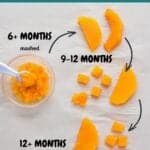













Thank you for the recipe. But for the roasted method “Brush both halves with water and seasoning(s) of choice. Place the squash cut side down on the baking sheet. Roast until the flesh is soft and fork-tender, about 30-45 minutes, for 1 ½ to 2 pound squash.” You meant to brush both halves with oil, right?
Oh my goodness thank you for bringing this to my attention! Yes brush with oil!